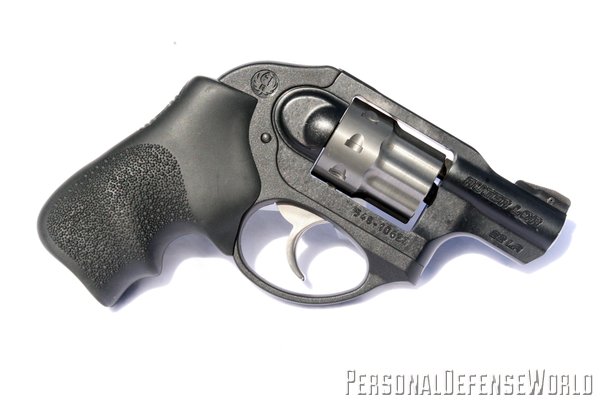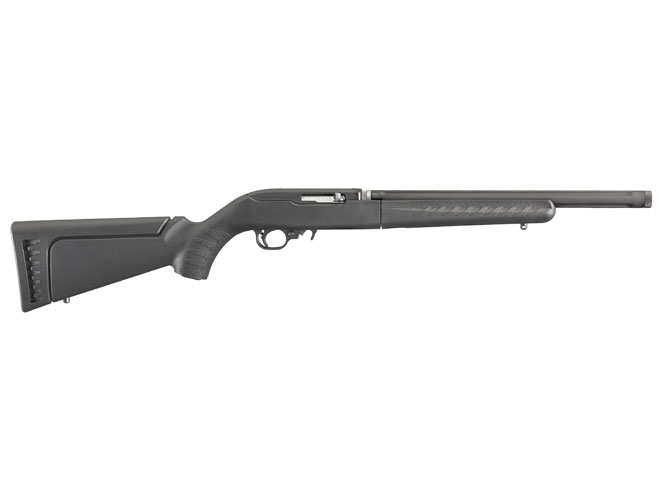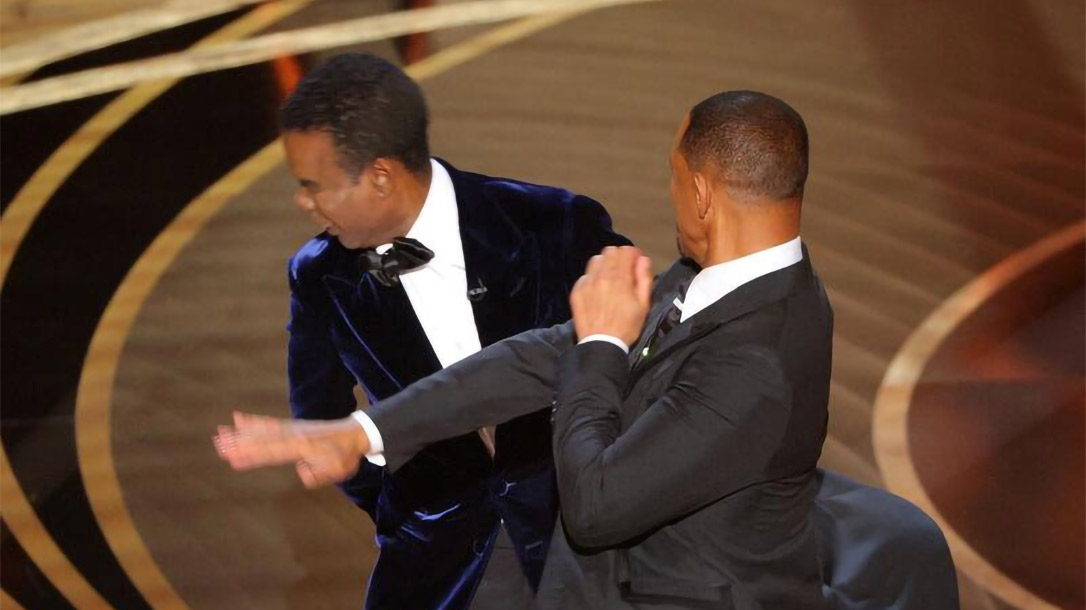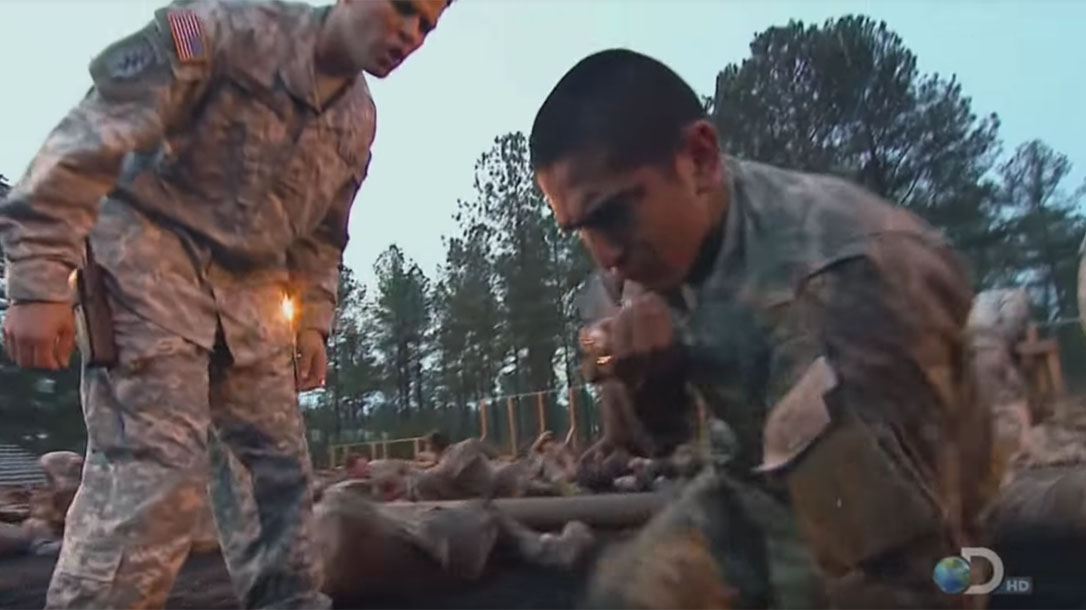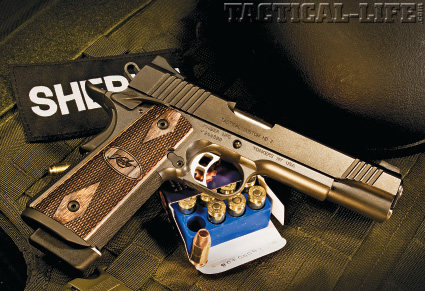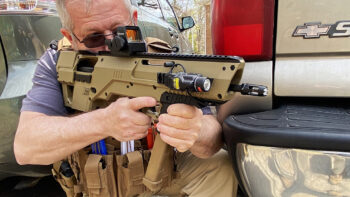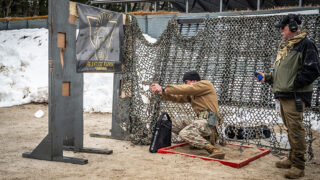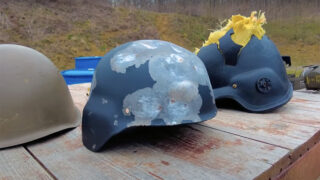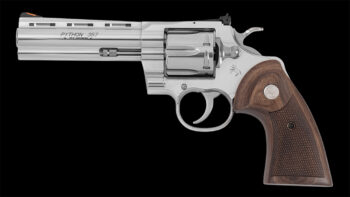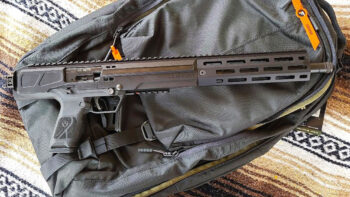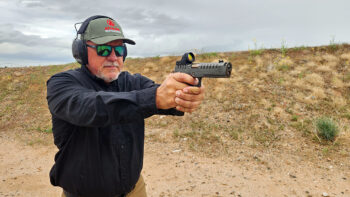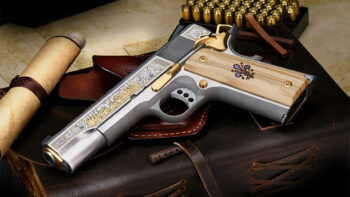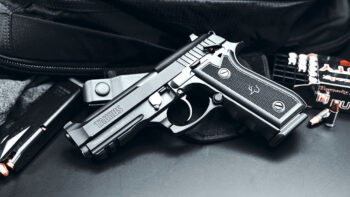The introduction of the ingenious Lightweight Compact Revolver (LCR) a few years ago scored another hit in Ruger’s long line of super-popular handguns. Originally offered as a five-shot .38 Special and then augmented with a slightly longer-cylindered .357 Mag version, the LCR is now available as an eight-shot .22 LR rimfire.
First Look
As the new .22 comes out of the box, the discerning eye quickly sees that it’s not quite the same gun as the larger caliber versions. The cylinder is thinner forward of the locking notches, and of course, there are more flutes in the distinctively fluted cylinder to allow for eight chambers. A large gap between the front half of the cylinder and the rest of the frame window is distinctly apparent. The screw at the top of the frame, deemed necessary for the centerfire LCR during early factory testing, is absent thanks to this variation’s mild caliber, which imparts so much less recoil force to the revolver.
In the hand, it feels almost exactly the same as its big brothers. On a calibrated scale, my “old” LCR .38 Special weighed a hair under 14 ounces, unloaded. The .22 tipped the same scale exactly one ounce more. The difference wasn’t noticeable.
Operation is exactly the same, except for the obvious fact that a fully loaded LCR .22 will give you eight “bangs” before you get a “click,” compared to five in .38 or .357. Ruger ads for the LCR confidently promise “the best double-action trigger pull in the world.” This, of course, is subjective. The same ad continues, “We believe the LCR has the best factory double-action trigger pull of any small-frame revolver on this planet. We challenge you to try it for yourself. The non-stacking trigger pull on every award-winning LCR is light, smooth, and manageable, making the LCR a lightweight, compact revolver you can rely upon when it matters most.” A careful reading shows that they’re not calling it the lightest such trigger. And with the LCR .22, it isn’t. Which brings us to…
Trigger Pull
The test LCR, serial number 548-10623, was too much for the digital trigger pull gauge, which tops out at 12 pounds. Every stroke resulted in a reading that said, “Over.” By contrast, my LCR .38 Special, a relatively early sample with serial number 540-01873, averaged 10.3 pounds. Pulls were measured from the center of the trigger, where the shooter’s index finger was likely to be.
The .22 version of the LCR comes with a much heavier mainspring than the centerfire models. The rationale is that .22 rimfires, unlike centerfire cartridges, bring headspace issues due to varying rim thicknesses and priming sensitivity in the billions of such cartridges that are out there. A heavy hit with the revolver’s hammer, an internal hammer in the case of this double-action-only design, is thus deemed necessary.
All who tried the test gun—dry fire with the yellow plastic cushioning ring that comes with it, and live fire with assorted ammunition—commented that while the trigger pull of the .22 LCR was certainly smooth, it felt heavy.
Back in the late 1990s when S&W brought out its feathery little Model 317 .22 LR, it also had a very heavy main-spring. Writing about it right here in Complete Book of Handguns back then, I turned my own sample over to masterful armorer Rick Devoid at Tarnhelm Supply. He put in a standard mainspring from a Smith & Wesson Chief Special .38, and wonder of wonders, that little S&W .22 just perked along with 100% reliability no matter what kind of crappy .22 ammunition we fed it. Rick has since done that conversion for many other customers with S&W .22 revolvers, and I’ve never heard a complaint.
Was there a chance that the same would work with the Ruger LCR? There was only one way to find out.
I turned my LCRs in .38 and .22 over to Bill Pfeil, the gunsmith at ProArms, Inc. With the .38’s mainspring in it, the .22 LCR now delivered a pull weight on the digital gauge of an average 10.3 pounds. That was dramatically lighter than what I had estimated as more like a 14-pound pull on the .22 LCR as it came out of the box. I was eager to take it to the range.
Alas, it was too good to be true. We got one or two misfires out of every eight-shot cylinder. What’s good for the goose isn’t always good for the gander, and what works on a Smith & Wesson will not necessarily work on a Ruger. It turned out that there was a darn good reason why Ruger put that heavy mainspring in the LCR .22 LR.
The good news is that when assessing double-action trigger pulls, smooth is a whole lot more important than light, and the LCR in every chambering comes through as smooth as Ruger’s advertising promises. That became evident when we took the gun to the bench for 25 yard accuracy testing.
Range Time
Setting a Matrix rest on a concrete bench at 25 yards, I tried three different .22 LR loads for accuracy. Winchester T-22, a standard velocity lead bullet round, is intended as an economy product for competitive target shooting. Presumably geared for long barrel target .22s, it did not do its best from the 1.88-inch barrel of the pocket-size LCR. The five-shot group measured 3.9 inches. However, I also measure the best three hits of every five-shot group, on the theory—tested and proven to this writer’s satisfaction long ago—that this takes enough unnoticed human error out of the equation to give a good idea of what the same gun and ammunition would have done with all five shots from a machine rest. In this case, the “best three” cluster measured 0.6 inches—an indication that there was more accuracy built into this gun than the shooter (me) was capable of wringing out of it with every shot. One of the two farthest hits had produced a slightly elliptical bullet hole, evidence of a bullet that was starting to “keyhole” from the short 1.88-inch barrel.
Next up was CCI’s copper plated Mini-Mag, with a solid bullet. That did a little better overall, with the five shots 3.05 inches apart. (All measurements were taken center to center between the farthest-apart bullet holes being measured, and to the nearest 0.05 inches.) The best three in the Mini-Mag group were 1.25 inches.
Finally, I tried Federal’s inexpensive Game Shok load, with a 40-grain solid bullet. This ammunition rewarded me with another 3.05-inch cluster (how’s that for consistency?) for all five shots. Four of those, including a very tight “double,” were in 1.15 inches, and thanks to that snug double, the best three were in 0.55 inches. I find that truly amazing from a snub-nose .22 pocket revolver.
Shooting Impressions
At 7 yards, rolling the trigger at a pace consistent with the old PPC service revolver qualification, the LCR .22 put every round into a 1.25-inch group in the head. Six of the eight shots were a tad low left. This was consistent with where the gun threw its shots from the 25 yard line: All three test loads averaged two to three inches low at that distance, and slightly left. The elevation, at least, should be readily correctible with a bit of judicious file work on the front sight.
Let’s put that in perspective. The rule of thumb that seems to have been established over the years is that “4 inches at 25 yards is acceptable service pistol accuracy.” Yeah, I know, that seems generous; I’d like my service size handguns to shoot tighter than that, and I’m sure you would too. But you and I don’t get to make the standards. They’ve evolved as they have, and they are as they are.
By that standard, with its 1.88-inch barrel, heavy trigger pull and all, this little pocket revolver shot easily within “service pistol” accuracy standards. I for one think that speaks pretty well of the LCR .22 LR. (Yes, the heavy mainspring was in the gun for the accuracy testing.)
The simple fact is that heavy trigger pulls aren’t that hard to deal with, so long as the pull is smooth, and it most certainly is smooth on the whole LCR line including this new .22 LR. When you look at the “best three shots” group measurements in particular, it becomes clear that the LCR .22 LR is capable of better accuracy than one would expect from a small double-action-only revolver.
The key to shooting this type of gun well is a hard hold. The light target-shooter’s grasp works fine on a heavy .22 target pistol that has a very short, very crisp, and very light trigger pull. With a sub-one-pound revolver with a much longer trigger stroke that’s more than a dozen times heavier than the weight of the gun itself, we have a totally different set of dynamics to control, which means a totally different grasp is called for.
Without exception, petite female to large male, every member of our test team shot the LCR .22 best with a very firm grasp. This stabilized the gun’s very light weight—one feature the LCR .22 will be bought for, after all—against that long, heavy trigger pull. Placing the trigger finger with the distal joint centered on the trigger instead of the pad of the finger gives the shooter much more leverage with which to smoothly roll that trigger back. Different tools simply require different techniques.
We did notice that if the muzzle was not held straight up, it was possible to get a spent casing caught under the ejector star. This was strictly a human error thing that can happen with many other revolvers. While ejection was clean and smooth, we noticed that the front of the ejector rod was narrow with a rather sharp circle, which could have been unpleasant to the hand if we’d had to really whack out stuck casings. Fortunately, none of us did.
The Understudy Factor
The concept of a pocket size, high-quality .22 revolver goes back to the Smith & Wesson .22/32 Kit Gun of 1936. It was introduced with a 4-inch barrel, which was always its most popular configuration. The snub-nose version came later. Sportsmen who wanted to make a headshot on a squirrel or a snapping turtle for the pot with their little S&W .22 generally chose the 4-inch tube. The snubby version came into its own with cops and armed citizens who carried a snub-nose S&W .38, and wanted a practice gun that duplicated the feel of their carry piece, but with cheap ammu-nition and less punishing recoil. The LCR .22 fits this niche perfectly for the many who have chosen a larger caliber LCR as one of their concealed carry options.
For draw-to-the-shot practice, the .22 LCR has no downsides. Except for the trigger pull being a little heavier, everything else is the same as on the more powerful versions. Only after the recoil of the first shot do the dynamics change. To get recoil control down pat, in double taps or sustained fire, the shooter of course wants to be practicing with the same power level as what will be in the gun when it must be fired in self-defense. However, for everything else – for getting the gun out, for getting it on target, for developing the “feel” of it in point shooting – the LCR delivers economical “reps” that build skill, and do so without punishing hand and wrist with +P recoil through a light frame.
Final Notes
I like the Ruger LCR. I liked it from the first time I fired it back when it was introduced. I bought my test sample, and have occasionally carried it by choice. I’ve used it to demonstrate with on “Personal Defense TV” on the Sports-man Channel, and wielded an LCR .38 in three of my segments on that show in the current season.
I like the LCR .22 LR, for the reasons stated above. Yes, the trigger pull feels heavy, but so long as it’s smooth (and it is!), I’m happy with it. I will eventually get around to filing down the front sight to eliminate the low point of impact in relation to point of aim. No biggie. The adjustable Crimson Trace Lasergrips that can be ordered from Ruger or bought at your local gun shop for the LCR are another solution to that. And, for all I know, the one you buy may shoot spot on to the sights for you from its first moment on the range.
At a suggested retail of $525, the LCR .22 LR is a solid value that’s 100% reliable if you don’t mess with the mainspring. I don’t see any .22 LR as a dedicated self-defense gun, unless the shooter’s hands and wrists are physically debilitated, and in that case the shooter might want a gun with a lighter trigger pull. At the same time, in a life-threatening emergency, eight rounds of high speed .22 LR would beat heck
out of a can of pepper spray.
As a fun gun, and as a practice tool for the person relying for defensive needs on a larger caliber LCR, I think this little .22 LR is great.
As of mid-summer 2012, Ruger had manufactured 1.2 million fire-arms since the beginning of the year. Useful, innovative designs such as the LCR .22 are one rea-son for that spectacular popularity. To learn more, visit ruger.com.









